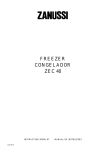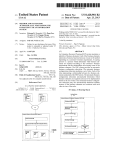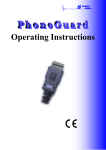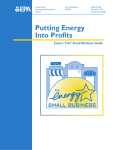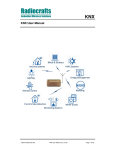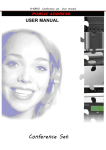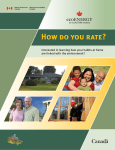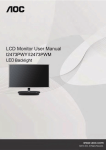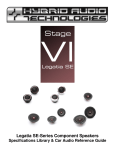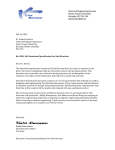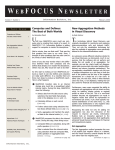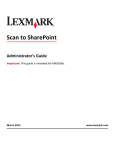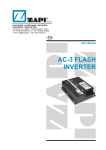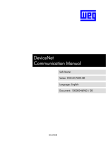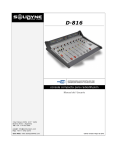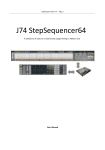Download Test ) Procedur
Transcript
Before the UNITED STATES DEPARTMENT OF ENERGY Washington, D.C. In the Matter of Energy Conservation Program: Test Procedure for Set-top Boxes Docket No. EERE– 2012–BT–TP–0046 RIN 1904–AC52 ) ) ) ) ) 10 CFR Parts 429 and 430 COMMENTS OF THE CONSUMER ELECTRONICS ASSOCIATION I. Introduction and Summary The Consumer Electronics Association (CEA) appreciates the opportunity to submit comments on the Department of Energy’s proposed test procedure for set-top boxes as published in a notice of proposed rulemaking on January 23, 2013. We recognize the substantial efforts DOE and its contractors have made to develop a federal test procedure, but we firmly believe that these resources are wasted and the efforts are misguided. CEA is the preeminent trade association promoting growth in the $209 billion U.S. consumer electronics industry. CEA represents more than 2,000 companies across the consumer electronics industry, including a wide range of set-top box manufacturers, component manufacturers and service providers in a number of sectors. For many years, CEA has been on the vanguard of energy efficiency initiatives related to the consumer electronics industry and has supported and advanced energy efficiency as part of the industry’s broader commitment to environmental sustainability. CEA’s comprehensive 1 approach to energy efficiency includes initiatives related to public policy, consumer education, research and analysis, and industry standards. One of these initiatives, industry’s involvement in the successful ENERGY STAR program, is over 20 years old. CEA opposes the adoption of a federal test procedure and federal energy standards which are the only credible and legal rationale for a federal test procedure (i.e., for a “covered product”). DOE’s effort, apparently conducted in indifference to the sequestration and other federal spending constraints, is totally unnecessary. Rather, DOE should defer to the consensus process, where interested industry and non-industry stakeholders are completing the test procedure known as “CEA-2043” which properly constitutes the United States testing standard for measuring power consumption in set-top boxes. DOE, its contractors, the U.S. Environmental Protection Agency and energy advocates are and have been represented in the consensus standard development of CEA-2043. DOE’s development of a test procedure to facilitate a federal energy standard is unnecessary and deleterious to the national interest because such standards cannot be justified under the Energy Policy and Conservation Act (EPCA) and will be harmful to innovation, consumer choice and product utility. As explained further below, a voluntary agreement adopted by all the major multichannel video providers and set-top box manufacturers already has saved an enormous amount of energy, will evolve progressively and will continue to cumulatively provide enhanced benefits into the future. II. DOE is Required by Law and Policy to Defer to the CEA-2043 Standard The American National Standards Institute (ANSI) formally recognizes select organizations to develop essential industry standards. CEA is accredited by ANSI to create and maintain American National Standards (ANS). This accreditation ensures that CEA’s standards development program meets strict procedures and requirements for due process and criteria for the approval and withdrawal of ANS. With more than 70 committees, subcommittees and working groups and roughly 1,100 participants, the CEA Technology & Standards program maintains an unmatched reputation as a credible and flexible standards making body. 2 When a CEA standard is developed for submission to ANSI as an American National Standard, the rules and procedures described in ANSI Essential Requirements: Due process requirements for American National Standards (Edition: January 2013)1 must be strictly followed. Due process demands: openness; lack of dominance; balance of interests; coordination and harmonization with other standards bodies; public notification; prompt consideration of views and objections; consensus vote procedures; an appeals mechanism; and written procedures. These due process requirements are described in detail by ANSI. CEA, as an ANSI-accredited standards developer, is required to comply with the normative policies and administrative procedures established by the ANSI Executive Standards Council. In addition to the ANSI Essential Requirements, CEA maintains its own, additional layer of procedures to further guide participants in standards setting activities. CEA’s Technology & Standards Council (TSC), formed in accordance with CEA’s corporate bylaws, is responsible for overseeing CEA’s standards programs. All CEA standards committees are created by the TSC. In addition, the TSC is responsible for the creation, maintenance, and revision of the procedures manual known as CEA Procedures: Technology & Standards Procedures Manual (EP-23-N, revised July 2011).2 Finally, the Consumer Electronics Association Legal Guides (revised July 2009) supplements the procedures contained in EP-23-N.3 The open, transparent, and fair development of consensus standards that accurately reflect the interests of all stakeholders can only be ensured through the rigorous process described here. Draft CEA-2043, Set-top Box (STB) Power Measurement, is consistent with ANSI rules and procedures, which are well recognized in the United States and throughout the world. Dozens of meetings, multiple draft revisions, and countless technical discussions and debates have led to a robust draft testing procedure that will serve all stakeholders equally. The development of CEA-2043 has been open for participation by all interested parties. As noted previously, participants include DOE, both its employees and contractors, EPA and its contractors, and energy efficiency advocates. The current roster of the CEA R4 Committee, 1 This document is publicly available at http://www.ansi.org/essentialrequirements. This document is publicly available at http://www.ce.org/CorporateSite/media/Standards-Media/EP23N_Final.pdf. 3 This document is publicly available at http://www.ce.org/CorporateSite/media/StandardsMedia/CEA_Legal_Guides_7-15-09.pdf. 2 3 Working Group 13 (R4WG13) Committee, which is developing CEA-2043, includes DOE, EPA, Lawrence Berkeley National Laboratory, Navigant, the Natural Resources Defense Council, Energy Solutions, and Terra Novum as well as numerous service providers, and manufacturers of both set-top boxes and their internal components. Although we recognize and appreciate that DOE has proposed adopting in large measure CEA-2043, U.S. law and good public policy favors simply relying on the standard rather than borrowing from, modifying or reinventing it. Revisions to the draft CEA standard that DOE believes would be beneficial can and will be incorporated into CEA 2043 where technically justified, as discussed in detail in an appendix to these comments (CEA Technical Comments – NOPR for Test Procedure for Set-top Boxes, attached). The National Technology Transfer and Advancement Act (NTTAA) and the Office of Management and Budget (OMB) Circular A-119 evidence clear preference for voluntary and market solutions in these circumstances. Under the NTTAA, DOE, as a federal department, is required to use technical standards that are developed or adopted by voluntary consensus standard bodies unless these standards are inconsistent with applicable law or otherwise impractical. The law codifies OMB Circular A-119 which also explains that the term “‘use’ means incorporation of a standard in whole, in part, or by reference for procurement purposes, and … in regulation(s).”4 The Congressional findings in NTTAA provide that the legislation is intended to, among other things, “enhance technological innovation for commercial and public purposes” and to “promote the adaptation of technological innovations[.]”5 A mandatory testing standard for set-top boxes promulgated by DOE would not serve these purposes. Similarly, OMB Circular A-119 notes that use of voluntary consensus standards is aimed at encouraging long-term growth for U.S. enterprises and promoting efficiency and economic competition through harmonization of standards. Given the fast pace of technology innovation, DOE’s adoption of a mandatory test procedure would be inefficient and only hinder these goals. Further, this Administration in Executive Order 13563 and other pronouncements set as federal policy the promotion of innovation and consideration of regulatory approaches that 4 5 See http://www.whitehouse.gov/omb/circulars_a119 at 6(a)(1). See 15 U.S.C. § 3701. 4 reduce burdens and maintain flexibility and freedom of choice for the public, requiring that new regulation take into account the evolving nature of emerging technologies and promoting innovation. Under this policy, there is no justification for a federally adopted test procedure for set-top boxes unless it is a predicate for federal standards. In the separate DOE “covered product” proceedings for set-top boxes, a multitude of comments have shown that a federal energy standard is clearly ill advised and not compatible with the law. The covered product threshold cannot be met, the set-top box is not an appropriate “consumer product,” and the myriad contractor analyses are looking at the wrong issues in the wrong ways. Forthcoming comments on the documents contained in DOE’s recent Notice of Document Availability (NODA) will specify the flawed assumptions and gross incompatibility of the shopworn DOE contractor models and analyses for this product category. III. A Federal Test Procedure is Unnecessary and Deleterious to Public Policy Not only has the consensus process satisfied the need for a national, uniform test procedure for set-top boxes, but a Set-Top Box Energy Conservation Agreement (“Voluntary Agreement” or “VA”) entered into by the key purchasers and manufacturers of set-top boxes ensures enormous short-term and long-term energy savings while allowing set-top boxes and related technology and networks to innovate and drive toward system wide efficiencies.6 Although it is unfortunate that energy advocates ultimately chose not to join the Voluntary Agreement, the process was and remains open to such parties. Energy efficiency advocates are encouraged to re-engage and provide technical and policy input, particularly with respect to ensuring compliance with the commitments and developing future commitments, and hopefully become signatories in the future. It is particularly inappropriate and unjustified for DOE to take the position in the NODA with respect to energy standards analysis that DOE only will consider a “non-regulatory agreement reached between all stakeholders as an alternative to a regulatory standard” (emphasis added). This not only defies reality, but it is unnecessary and undesirable under the law. A voluntary agreement in Europe has been entered into unilaterally by industry with active 6 The Voluntary Agreement was announced on December 6, 2012, and is available at http://www.ce.org/News/News-Releases/Press-Releases/2012-Press-Releases/Set-Top-Box-Energy-ConservationAgreement-Expected.aspx. 5 European Commission participation and support. Industry seeks substantial involvement by DOE and energy efficiency advocacy groups in the U.S. VA. Fundamentally, however, the energy savings are no less real or meaningful because certain parties who manufacture nothing and purchase no set-top boxes are not participating. DOE should not allow such stakeholders to effectively hold hostage legitimate actions by industry. We recognize that DOE has a fast-track regulatory process which does depend on the consensus of industry and non-industry parties, but that is not the activity in question here. DOE must take into account the reality of industry’s own efforts through the VA and give the VA an opportunity to work. The essence of the Voluntary Agreement is that 90 percent of all new set-top boxes that a service provider signatory purchases and deploys after December 31, 2013, shall meet the efficiency standards established in the ENERGY STAR Version 3.0 specification. In addition, the relevant sectors – the cable industry, satellite and telecommunications firms– have made their own specific, additional undertakings. Critically, the agreement allows for the commitments to be revised and additional goals established over time in order to keep pace with the technological capabilities and architectural evolutions occurring within subscription video delivery sector. The VA has been adopted with specific intent not only to save energy but to ensure there are no restrictions on future innovation, technology or competition to the detriment of the United States economy or consumers. There are also strong provisions in place to ensure reasonable transparency, public reporting and verified compliance with these commitments. Under the VA, an organization has been created with a steering committee and rules. These provisions enable, among other things, establishment of an independent administrator and auditors to verify data submitted are reliable and demonstrate that key commitments of the VA are met. The VA also provides for not only laboratory testing but also testing in the home environment to better assure energy efficiencies are delivered. No federal or state standard can accomplish all this in such a short period of time while being sufficiently agile to adjust to market and technological realities and changes. In light of these meaningful industry efforts, DOE’s continued pursuit of a test procedure and standards is irrational. Whether justified by politics, bureaucratic momentum or excessive funds in certain departmental accounts, millions of dollars will be wasted on the test procedure 6 and standards rulemaking with no public benefit. Meanwhile, 244 employees are being laid off at DOE’s Hanford Nuclear Reservation in the State of Washington, and 2,000 others will receive multiple week furloughs delaying toxic waste contamination cleanup.7 No one else will do that work. Here, in the case of DOE’s proceeding for set-top boxes, hundreds of thousands of dollars or more are being squandered when there are productive, active energy conservation efforts already underway. Certainly, DOE at least should allow a period of time to monitor and evaluate the achievements and credibility of the VA before proceeding with a federal mandate. A federal test procedure is not needed to achieve uniform testing, provide a test procedure for Federal Trade Commission EnergyGuide labeling purposes, or support the ENERGY STAR program. Industries throughout the United States have developed useful, technically sound and widely adopted testing procedures. That is exactly the case with respect to CEA-2043. No information has been submitted which suggests that other test procedures will be adopted or used. Industry’s and the VA’s adoption of the CEA-2043 test procedure will ensure its preeminence. Although FTC EnergyGuide labeling might be considered as a consequence of the adoption of the test procedure and standards, the absence of a federal test procedure is not problematic for FTC purposes because an EnergyGuide label is neither justified nor useful. Only a miniscule number of set-top boxes are purchased directly by consumers who might benefit from a comparative label. Consumers purchase the services of a system, not a set-top box. The service providers who are signatories to the voluntary agreement, as well as smaller service providers, have access to plentiful energy use information when they make their procurement decisions. Moreover, under the VA, service provider signatories shall provide their subscribers and potential customers with reasonable access to energy efficiency information about the set-top boxes subject to the VA no later than January 1, 2014. EPA’s Version 2 ENERGY STAR Set-top Box Specification referenced ANSI/CEA2013 and ANSI/CEA-2022 (predecessor to the CEA-2043 standard). EPA’s Version 3 ENERGY STAR Set-top Box Specification referenced CSA C-380:8 (a Canadian Standards 7 See “Hanford Nuclear Reservation Workers Hit By Sequestration Layoffs,” Huffington Post, March 21, 2013, and letter from Daniel B. Poneman, Deputy Secretary of Energy, to the Honorable Jay Inslee, Governor of Washington, dated March 5, 2013. 7 Association derivation of ANSI/CEA-2013, ANSI/CEA-2022, and IEC 62087). EPA’s plan was to use CEA-2043 directly, hence its active participation in the CEA process. EPA’s proposed Version 4.1 specification references DOE’s NOPR but also references CEA-2043 (October 2012 draft) for tests not covered by the NOPR. If the NOPR is dropped, the ENERGY STAR program easily can adopt CEA-2043, as has been its original intent. The disadvantages and harm caused by a federal test procedure are not raised as an exercise in rhetoric and are quite different than the considerations that apply to more stable and mature consumer products and equipment. Digital set-top boxes, the focus of DOE’s NOPR, only have existed in widespread use since the mid-1990s. In the relatively short time since then, their use and design has evolved in several significant ways, including in response to requirements of the Federal Communications Commission and the transition to digital television broadcasting. It is therefore likely and predictable that a DOE test procedure promulgated today and locked into law will soon be at best irrelevant, not covering future and unanticipated applications and designs. Worse, a federal test procedure and related energy standard could stifle innovation and be detrimental to the U.S. economy and our international technological competitiveness. Even in the European Union, where regulatory mandates are frequently favored, a voluntary agreement for set-top box energy efficiency was established with support and encouragement by the European Commission, which officially recognized the agreement. Unnecessary U.S. federal regulation of set-top box energy efficiency and test methods could impact our leadership, competitiveness and innovation in the rapidly evolving market for video programming distribution. First and foremost is the grave threat that this test procedure poses for innovation and future consumer benefits and services. The nature of the set-top box, its constantly evolving design and technology and its place in a home network and content delivery system sets a federal mandated and rigid test procedure on a collision course with the evolving market and technology. Adapting testing standards and product standards which inevitably cannot anticipate and account for innovation not only means the consequential energy representations are inaccurate, but it also creates perverse incentives not to innovate. 8 Similarly, “deep sleep” or “off” modes, which are capabilities for reducing energy consumption by the set-top box during extended periods of inactivity or at specific times, save energy, but absent specific accounting in a test procedure it would be discouraged. The next innovation or potential energy-saving trend in this category is unpredictable. What is predictable is that a federally mandated test procedure for set-top boxes will not be sufficiently nimble to account for rapid product evolution. DOE’s proposed test procedure also treats as a separate “model” every combination of hardware and software having a different energy use profile. Literally, thousands of “models” will need to be tested and then as software/hardware combinations evolve, thousands more will need to be tested before any energy declaration can be made. This violates the “unduly burdensome to conduct” prohibition. Variations or exceptions from the federal test procedure will need to be justified and approved either through the laborious process of waivers under 10 CFR Section 430.27, or the even slower, onerous and uncertain process of hardship petitions under the Office of Hearings and Appeals. In contrast, the VA provides for efficient, technically competent, and expeditious procedures to deal with proposed variances or alternative measures –including those not recognized by a mandated test procedure– that meet or exceed the energy saving goals specified in the agreement. Section 12 of the VA relates to noncompliance and dispute resolution and provides for credits for “alternative energy efficiency steps which provide energy efficiency gain superior to those required by the voluntary agreement.” This includes “home networking and multi room solutions to share the resources of a primary device with lower functionality home network devices,” “moving set-top box recording, other functionality or applications into the network or cloud,” “delivering video services via Internet protocol without the need for a set-top box,” and “using digital transport adapters or using other adapters in lieu of set-top boxes.” In a number of these cases, under a federal test procedure and associated energy standard, these designs would be irrelevant, penalized, or perhaps even prohibited, thus hindering innovative, broader solutions which, overall, save more energy than direct set-top box measurement related to a standard. 9 It is critical to recognize that if the federal test procedure is established, it will become the law of the land. Absent the waiver or hardship petitions or the laborious multiyear process of revision, it must be followed scrupulously in all statements of energy use regardless of the pace at which the underlying technology changes or the consumer needs evolve. Deviation can result in compliance actions under EPCA by DOE, FTC, EPA, and even possibly state attorneys general and private parties. Thus, the adoption of a federal test procedure sets up an environment where innovation cannot move forward with changing consumer demand due to constraints of an ossified test procedure. The condition described is not idle speculation or arm waving by the industry. One need only look to other areas where government has intervened in a highly dynamic and complex product category. One can contrast DOE’s record in adopting revised test procedures with the ability of industry to quickly make revisions driven by the market. An accredited standards developing organization such as CEA has an agility that DOE does not. For example, CEA-861, A DTV Profile for Uncompressed High Speed Interfaces, which defines digital output data requirements for set-top boxes, was developed in 2001 and has been revised, as was required to keep up with innovations impacting previous versions, eight times in 10 years. CEA-2013/2022, CSA C-380 and IEC 62087 are set-top box power consumption measurement test procedures. They have been adopted and revised 10 times over a seven year period. In stark contrast, DOE’s test procedure for measuring power consumption in televisions was adopted in 1979. After 30 years, and only after being prompted by outside petitions, DOE repealed the test procedure in 2009. Its proceeding to adopt a new one commenced in September 2010 and is still pending. Many DOE test procedures take more than 10 years to amend, even just to cross-reference current consensus test procedures. We also note that there is no purpose in adopting an annualized energy metric, duty cycle or usage measures, and it is infeasible to do so. The CEA standard and most of DOE’s proposal measure power consumption using a defined configuration and performing a specific task. Attempting to predict annual energy consumption by taking a snapshot of constantly changing data in order to bootstrap standards and justify labeling is futile and dangerous. Such an approach requires specifying duty or usage cycles and hours of operation in various categories 10 (power modes) which are known to change and evolve every year. Duty cycle specifications necessarily place in regulatory concrete categories and times in these categories. Unless the definitions of all possible categories are 100 percent correct and future-proof, the annual power metric will be wrong in both axes –neither properly categorizing usage states nor the correct hours per day for each usage state. This metric fails the EPCA requirement that test procedures be “reasonably designed” to produce test results reflecting “representative average use.”8 Duty cycles set in federal concrete will be made obsolete by the consumer electronics marketplace and evolving consumer demand almost immediately. Worse yet, mandated duty cycles will inhibit innovation and energy-saving improvements. In this way, DOE’s proposed test procedure could foreclose opportunities to develop new duty cycles that save energy if such efforts could not be accommodated and measured under the DOE test procedure. Would every innovation be barred from the U.S. market until it receives a DOE waiver grant? For the reasons stated above, a federal test procedure is not only unnecessary, but it is also detrimental to the national interest in sound and progressive energy policy. Although we do not support a federal test procedure, the CEA R4WG13 Committee most definitely is not dismissing DOE’s proposed variances from the draft CEA test procedure. As discussed in Appendix A, a number of these differences likely will be incorporated in the final CEA standard. There are a few proposals in the NOPR which are either technically unsound or not suitable for a consensus test procedure. The CEA standard will be finalized and re-balloted in May 2013, in contrast to an undoubtedly prolonged DOE proceeding. IV. CEA Provides Technical Comments on Variances Between the Draft CEA-2043 Standard and the NOPR In Appendix A, we evaluate the NOPR’s variances from the CEA draft standard test procedure and explain how those variances are being addressed by the working group consensus process. Where the DOE NOPR is consistent with CEA-2043, we are not commenting. Where changes suggested in the DOE NOPR were not adopted by the working group, an explanation of why the changes were not accommodated is provided. Generally a change was not adopted for 8 See 42 U.S.C. 6293. 11 one of the three following reasons: (1) the input was additional instruction by the test requester (i.e., the DOE) that should be communicated directly to the party executing the test rather than documented within a test standard; (2) the input reiterated provisions already memorialized within the test standard; or (3) the input specified parameters relevant to regulation (were such regulation to exist) but were not appropriate for documentation within a test standard. To facilitate the review process by interested parties, cross-reference is generally provided to the DOE NOPR question that addresses the proposed modification. V. Conclusion CEA opposes the adoption of a federal test procedure and federal energy standards which are the only credible and legal rationale for a federal test procedure (i.e., for a “covered product”). DOE’s effort in this rulemaking is totally unnecessary. Rather, DOE should defer to the consensus process, where interested industry and non-industry stakeholders are completing the test procedure known as “CEA-2043” which properly constitutes the United States testing standard for measuring power consumption in set-top boxes. Respectfully submitted, CONSUMER ELECTRONICS ASSOCIATION By: _______/s/________________ Douglas K. Johnson Vice President, Technology Policy Bill Belt Senior Director, Technology & Standards 1919 S. Eads Street Arlington, VA 22202 (703) 907-7600 Charles Samuels Mintz, Levin, Cohn, Ferris, Glovsky and Popeo, P.C. 701 Pennsylvania Ave., N.W., Suite 900 Washington, DC 20004 April 8, 2013 12 APPENDIX A CEA Technical Comments – NOPR for Test Procedure for Set-top Boxes 13 CEA Technical Comments – NOPR for Test Procedure for Set-top Boxes Page 1 of 18 CLASS* Docket Number: EERE–2012–BT–TP–0046 RIN: 1904–AC52 Accept/ Disagree Existing Text DOE Comment/Modification/Addition CEA-2043 Work Group Consensus Disagree 4.16 Set-top Box (STB) — a device whose primary purpose or function is to receive video content which is then delivered to a Display Device, recording device, or Client. Definitions: Set-top box means a device combining hardware components with software programming designed for the primary purpose of receiving television and related services from terrestrial, cable, satellite, broadband, or local networks, providing video output using at least one direct video connection. OS Disagree none Definitions: Direct Video Connection - any connection type that is one of the following: High-Definition Multimedia Interface (HDMI), Component Video, S-Video, Composite Video, or any other video interface that may be used to output video content. The current Set-top Box definition covers the expanded details proposed by the DOE comment. For instance: 1.) "...hardware components with software programming..." is covered by the general term of "...a device...". 2.) "...and related services from terrestrial, cable, satellite, broadband, or local networks" is covered by the general term "...video content..." which covers all of DOE proposed sources plus any other possible delivery technology. 3.) "...providing video output using at least one direct video connection.." would exclude "headless devices" (e.g. an STB that delivers video using Wi-Fi, MoCA, 802.11, etc.) The standard, as written, will support testing of devices without "direct video connections". Only required if new DOE proposed definition was accepted. OS Disagree none Definitions: Content provider means an entity that provides video programming content. NOPR Question No. OS Q3 Q5 * Classification: TI - Tester Instructions – outside the scope of a test standard OS - Over Specification – covered by current CEA-2043 language R - Regulatory parameter - outside the scope of a test standard The term "content provider" is considered self-explanatory and does not require a definition. CEA Technical Comments – NOPR for Test Procedure for Set-top Boxes Page 2 of 18 OS Disagree 4.4 Digital Video Recorder (DVR) — a STB feature that records television signals on a HDD or other non-volatile storage device. A DVR often includes features such as: Play, Record, Pause, Fast Forward (FF), and Fast Rewind (FR). STBs that support a Service Provider delivery network based “DVR” service are not considered DVR STBs for purposes of this standard. The presence of DVR functionality does not mean the device is defined to be an STB. Definitions: Digital video recorder (DVR) means a STB feature that records television signals on a HDD or other non-volatile storage device integrated into the STB. A DVR often includes features such as: Play, Record, Pause, Fast Forward (FF), and Fast Rewind (FR). STBs that support a service provider delivery network-based “DVR” service are not considered DVR STBs for purposes of this test procedure. The presence of DVR functionality does not mean the device is defined to be a STB. Adding "...integrated into the STB" would exclude a device that is designed to always use an external HDD as supplied by the manufacturer. Section 8.1.8 indicates the correct treatment for essential peripheral devices. Accept but simplify DOE text 4.5 Display Device (DD) — a Display Device (e.g. TV, Computer Monitor, Portable TV, etc.) receives its content directly from an STB through a video interface (e.g. HDMI, Component, Composite, S-Video, etc.) and not through a Home Network Interface. 4.8 Home Network Interface (HNI) — the interface with external devices over a local area network (e.g. IEEE 802.11(Wi-Fi), MoCA, HPNA, IEEE 802.3, HomePlug AV). Definitions: Display device means a device (example: TV, Computer Monitor, or Portable TV) that receives its content directly from a STB through a video interface (example: HDMI2, Component Video, Composite Video, or S-Video), not through an HNI, and displays it for viewing. Definitions: Home network interface (HNI) means an interface with external devices over a local area network (example: IEEE3 802.11 (Wi-Fi), MoCA, HPNA, IEEE 802.3, HomePlug AV) that is capable of transmitting video content. Add - "…and renders it for viewing" none Definitions: Multi-stream means a STB feature that may provide independent video content to one or more clients, one or more directly connected TVs, or a DVR. Q5 Q5 OS Disagree Q5 OS Q5 Docket Number: EERE–2012–BT–TP–0046 RIN: 1904–AC52 Open The addition of "…that is capable of transmitting video content." is not sufficient to distinguish a class of HNIs. All HNIs are capable of transmitting video at some level. The standard, as written, will support testing of devices with all HNI types so the definition of HNI should not be restricted. A list of HNIs may be specified (and updated) outside of the standard. Not required since current text allows the entity using CEA-2043 to specify various configurations for testing. CEA Technical Comments – NOPR for Test Procedure for Set-top Boxes Page 3 of 18 - Accept none R Disagree - but clarifying text added 6.2 SLEEP A range of reduced power states where the STB is connected to a mains power source and is not providing any Principal STB Function. The STB may transition to ON or OFF mode due to user action, internal signal, or external signal. The power consumed in this mode may vary based on specific use or configuration. If any Principal STB Function is activated while operating in this mode, the STB is assumed to transition to ON mode. Monitoring for user or network requests is not considered a Principal STB Function. Q6 Docket Number: EERE–2012–BT–TP–0046 RIN: 1904–AC52 Acronyms: ANSI means American National Standards Institute. IEC means International Electrotechnical Commission. ISO means International Organization for Standardization. SCTE means The Society of Cable Telecommunications Engineers. Inc. Definitions: Sleep mode – a range of reduced power states where the STB is connected to a mains power source and is not providing any principal STB function. The STB may transition to on or off mode due to user action, internal signal, or external signal. The power consumed in this mode may vary based on specific use or configuration. If any principal STB function is activated while operating in this mode, the STB is assumed to transition to on mode. Monitoring for user or network requests is not considered a principal STB function. The STB shall be able to transition from this mode to on mode within 30 seconds to be considered in sleep mode. Add acronyms with meanings to standard. The standard should not contain performance limitations in a definition. However the following text will be appended to the definition in lieu of the DOE proposed text - "An STB may be expected to transition from Sleep mode to On mode within a specified time interval however such considerations are outside the scope of this standard" CEA Technical Comments – NOPR for Test Procedure for Set-top Boxes Page 4 of 18 Q7 Accept but simplify DOE text none Docket Number: EERE–2012–BT–TP–0046 RIN: 1904–AC52 Test Conditions: 1. For STBs that require subscription to a service, select the simplest available video subscription that supports all functionality specified in this test procedure (example: HD streaming, multi-stream, DVR, etc.). That is, select a subscription with TV services only; services with non-video capability, such as telephony, shall not be selected. Information will be added to Section 8.1 Test Procedures - General 2. If the STB can be installed by the consumer per the manufacturer’s instructions without the service of a technician, then install and setup the STB according to the instructions provided in the user manual shipped with the unit. Setup the STB using only those instructions in the user manual. Setup is considered complete once these instructions are followed. OS/TI Q14 Disagree 8.1.4 STB configurations that require a home network STB configurations that require the use of a home network shall use the Home Network Interface option (HNI) as provided by the entity specifying the use of CEA-2043. The HNI option used for the testing must be recorded by the tester. 3. If the STB must be installed by a technician per the manufacturer’s instructions, then it shall be setup as installed by the technician using this test procedure. All steps that a technician would follow when installing a STB for use in a consumer residence should be followed. Information about each of the steps that were performed to setup the STB by a technician shall be recorded and maintained by the manufacturer pursuant to 10 CFR Part 429.71. Home Network Connection. STB configurations that require the use of a home network shall use the HNI option according to the following order of preference. The first available connection that the STB supports shall be used: 1. MoCA; 2. HPNA; 3. Wi-Fi (802.11); or 4. Other HNI connection. HNI Technologies will change over time so it is best to specify the list of types and preferred order of use outside of the standard. CEA Technical Comments – NOPR for Test Procedure for Set-top Boxes Page 5 of 18 - Accept Q15 Q17 Accept Docket Number: EERE–2012–BT–TP–0046 RIN: 1904–AC52 8.1.5 STBs requiring broadband service If the UUT includes a HNI, and the HNI must be connected to broadband service for operation of a principal function of the UUT, it shall be tested while connected to a broadband network. Broadband performance criteria (i.e. download speed, upload speed, latency, etc.) must meet the specified requirements of the UUT to fulfill the principal functions. Broadband Service. If the STB includes an HNI, and the HNI shall be connected to broadband service for operation of a principal STB function, it shall be tested while connected to a broadband network. Broadband performance criteria (that is, download speed, upload speed, latency, etc.) shall meet the specified requirements of the STB to fulfill the principal STB functions. For STBs designed to operate both with a broadband connection and a service provider network connection, the service provider connection takes precedence, and the broadband connection shall only be made if the STB requires it for operating a principal STB function. Section 8.1.5 will be rewritten to accommodate the DOE comment and clarify the requirement. 8.1.7 Input Signal Equipment When an ODU, OTA antenna amplifier, CATV distribution amplifier, or similar signal equipment is required and the power for that equipment is supplied from the UUT, then the measurement must not include the power consumption of that equipment. Accordingly, the signal equipment shall be powered from a source other than the UUT. Input Signal Equipment When an ODU, OTA antenna amplifier, CATV distribution amplifier, or similar signal equipment is required and the power for that equipment is supplied from the STB, then the measurement shall not include the power consumption of that equipment, unless the equipment cannot be powered from a source other than the STB. If the signal equipment cannot be powered from a source other than the STB, then the power for this equipment shall be included in the STB power consumption measurement. However, if the signal equipment can be powered from a source other than the STB, then it shall be powered from another source, and such equipment shall not deliver any power to the connected STB. Section 8.1.7 will adopt the DOE proposed comment. New text: 8.1.5 STBs requiring additional data connections All data connections required for normal operation of Principal Functions must be connected. Data connection performance criteria (i.e. download speed, upload speed, latency, etc.) must meet the specified requirements of the UUT to fulfill the principal functions. CEA Technical Comments – NOPR for Test Procedure for Set-top Boxes Page 6 of 18 TI Disagree Q7 OS/TI Q20 Disagree - but clarifying text added OS Disagree 8.1.11 Test Configuration Information A STB is configured with one or more devices (e.g. display devices, network devices, service delivery devices, etc.) and, if applicable, configured with the network technology most commonly used in subscriber installations. Identically featured STBs often have different performance capabilities. Additionally, not all CEA-2043 tests apply to all STB types or configurations. Therefore the entity specifying the use of CEA-2043 is expected to provide the following information: (a) Test Configurations – a configuration diagram of the STBs, Clients, Display Devices, and any other devices required for each requested CEA-2043 test (b) The specific network technology to be used for each test, if applicable (c) The maximum number of connected Display Devices for each test, if applicable (d) The maximum number of Clients for each test, if applicable (e) Devices in the network configuration that cannot to be tested (e.g. PCs, Tablets, etc) (f) Required tests to be run on each device (g) Test parameters for each required test (e.g. TON, TSLEEP) Annex D (section D.2) includes recommended CEA-2043 test procedures for common STB types. Docket Number: EERE–2012–BT–TP–0046 RIN: 1904–AC52 Since 2043 supports user specified Test Configuration Information configurations for testing a STB it is better to Test Configuration The display device and client setupkeep the standard flexible to accommodate is described in Table 1 (of the NOPR). Based on the other possible configuration test requests. For example, EPA has already found it capability of the STB, the appropriate number of necessary to propose a test supplemental to display devices and clients shall be connected. the DOE’s proposal in order to test a device when some outputs are constrained. By keeping the standard flexible, the test method can be more useful. Test Configuration Information Connecting to a Display Device. The STB shall be connected to the number of display devices required based on the setup requirements specified in Table 1 (of the NOPR). The following order of preference shall be used to connect each display device to the STB. The first available connection that the STB supports shall be used: 1. HDMI 2. Component Video 3. S-Video 4. Composite Video 5. Other video interface Test Configuration Information Connecting to a Client. The STB shall be connected to the number of clients required based on the setup requirements specified in Table 1 (of the NOPR). An HNI connection shall be used to connect the client to the STB. The order of preference in which an HNI connection shall be selected is specified in section 4.6.1. (Of the NOPR). Add the following clarifying text to item C "…and by priority specified, if desired." Keeps original text as it accommodates an entity specifying the HNI interface requirements. CEA Technical Comments – NOPR for Test Procedure for Set-top Boxes Page 7 of 18 Q20 Q21 Accept but simplify DOE text 8.2.2.1 ON (Watch TV) The ON (Watch TV) mode power level shall be determined as follows: (a) Configure the UUT as specified in 8.1.11 (b) Select a channel* and view on a connected Display Device, if supported or, if not supported, view on a Client (c) Begin ON mode power consumption measurement and record the power consumption as PWATCH TV_n ,where n is the total number of Display Devices and Clients (d) Repeat steps (b) and (c) up to the maximums specified in 8.1.11. * For STBs using a content provider that does not support channels, select content that meets section 8.1.2 requirements and view the content as indicated. Docket Number: EERE–2012–BT–TP–0046 RIN: 1904–AC52 Test Conduct. The following section is provided as guidance when conducting the various on, sleep, and off mode tests. When multiple streams are enabled, different content shall be selected to output to a display device, record on a DVR integrated into the STB, and stream to a connected client. Output to a Display Device. For tests requiring output to a display device, a channel shall be selected and viewed on the connected display device(s) as required by the test configuration. For STBs using a service provider that does not support channels, an appropriate SD or HD test stream shall be selected and the content shall be viewed as indicated. If more than one display device is connected to the STB based on the test configuration from Table 1 (of the NOPR), then the content outputted on each display device shall be different. Streaming to a Connected Client. The content streamed to a client shall be selected in the order of preference proposed in the NOPR depending on the number of streams enabled. The first available stream that is supported by each connected client shall be enabled and the content on each stream shall be different. Stream with recorded content. That is, previously recorded content shall be viewed on a display device connected to a client. Stream with channel content. That is, a channel (SD stream for an SD client and HD stream for an HD client) shall be viewed on the connected display device. For clients that do not support channels, select an appropriate SD or HD test stream and view the content as indicated. Other streaming option. If the streams from sections 5.3.3.1. and 5.3.3.2. (of the NOPR) are not supported, use another stream that is available. Change step (d) to: “Repeat steps (b) and (c), using different content, up to the maximums specified in 8.1.11. Add text to 8.1.2: indicate if entity wants to specify additional stream parameters that can be done but is outside the scope of the test procedure. Review 8.1.11: allows for specification of content stream sources. "A configuration diagram should include the sources for test streams..." CEA Technical Comments – NOPR for Test Procedure for Set-top Boxes Page 8 of 18 - Accept 8.2.2.3 ON (Record) - DVR STB The ON (Record) power level shall be determined as follows: (a) Configure the UUT as specified in 8.1.11 (b) Select a channel using a connected Display Device or a Client, and record the program (c) Begin ON mode power consumption measurement and record the power consumption as PRECORD_n , where n is the total number of recordings (d) Repeat steps (b) and (c) up to the maximums specified in 8.1.11 Recording for a STB with DVR capability. For tests that require recording on a DVR, a channel shall be selected using a connected display device or a client and the program shall be recorded. If more than one recording is enabled on a DVR that is integrated into the STB, the content for each recording shall be different. Change step (d) to: “Repeat steps (b) and (c), using different content, up to the maximums specified in 8.1.11. Disagree 8.2.2.2 ON (Play) - DVR STB The ON (Play) power level shall be determined as follows: (a) Configure the UUT as specified in 8.1.11 (b) Select a previously recorded program and view on a connected Display Device or Client (c) Begin ON mode power consumption measurement and record the power consumption as PPLAY_n, where n is the total number of Display Devices and Clients (d) Repeat steps (b) and (c) up to the maximums specified in 8.1.11. Stream with recorded content. That is, previously recorded content shall be viewed on a display device connected to a client. Current text accommodates request. Q22 OS Docket Number: EERE–2012–BT–TP–0046 RIN: 1904–AC52 CEA Technical Comments – NOPR for Test Procedure for Set-top Boxes Page 9 of 18 - Accept 8.2.1 ON Mode Power Consumption Measurement ON mode power consumption measurements must use the following procedure. Specific power consumption parameter names are identified in each test. (a) Use the time period for ON mode power consumption measurement from 8.1.11 (TON) (b) Record the energy consumed over the predetermined time period (c) Record the average power consumption as the energy divided by the time period Calculation of Average and Rated Power Consumption For all tests in the on, sleep, and off modes (sections 5.5, 5.6, and 5.7), the average power shall be calculated using one of the following two methods: 1. Record the accumulated energy (Ei) in kilo-watt hours (kWh) consumed over the time period specified for each test (Ti). The average power consumption is calculated as Pi = Ei/Ti. 2. Record the average power consumption (Pi) by sampling the power at a rate of at least 1 sample per second and computing the arithmetic mean of all samples over the time period specified for each test (Ti). Accept as proposed by DOE Disagree 8.2.1 ON Mode Power Consumption Measurement ON mode power consumption measurements must use the following procedure. Specific power consumption parameter names are identified in each test. (a) Use the time period for ON mode power consumption measurement from 8.1.11 (TON) (b) Record the energy consumed over the predetermined time period (c) Record the average power consumption as the energy divided by the time period On Mode Power Measurement The time period for each test in the on mode, TON, is 2 minutes. The standard, as written, will support testing of devices with this ON mode time measurement. No text changes are required. Q23 TI Q23 Docket Number: EERE–2012–BT–TP–0046 RIN: 1904–AC52 CEA Technical Comments – NOPR for Test Procedure for Set-top Boxes Page 10 of 18 R Q24 Disagree 8.2.2.1 ON (Watch TV) The ON (Watch TV) mode power level shall be determined as follows: (a) Configure the UUT as specified in 8.1.11 (b) Select a channel* and view on a connected Display Device, if supported or, if not supported, view on a Client (c) Begin ON mode power consumption measurement and record the power consumption as PWATCH TV_n ,where n is the total number of Display Devices and Clients (d) Repeat steps (b) and (c) up to the maximums specified in 8.1.11. * For STBs using a content provider that does not support channels, select content that meets section 8.1.2 requirements and view the content as indicated. Docket Number: EERE–2012–BT–TP–0046 RIN: 1904–AC52 Previously accepted changes will On (Watch TV SD) and On (Watch TV HD) accommodate DOE requirement for both SD 1. If supported, select an SD channel and view on the and HD streams. The standard, as written, connected display device. For STBs using a content will support testing with both SD and HD test streams. No text changes are required. provider that does not support channels, select an appropriate SD test stream and view the content as indicated. 2. If the STB supports HD streaming, repeat the test in section 5.5.2. (of the NOPR) using HD content instead of SD content and record this value as PWATCH_HD. CEA Technical Comments – NOPR for Test Procedure for Set-top Boxes Page 11 of 18 TI Q25 Disagree 8.2.2 ON Mode Test Procedures 8.2.2.1 ON (Watch TV) The ON (Watch TV) mode power level shall be determined as follows: (a) Configure the UUT as specified in 8.1.11 (b) Select a channel* and view on a connected Display Device, if supported or, if not supported, view on a Client (c) Begin ON mode power consumption measurement and record the power consumption as PWATCH TV_n ,where n is the total number of Display Devices and Clients (d) Repeat steps (b) and (c) up to the maximums specified in 8.1.11. * For STBs using a content provider that does not support channels, select content that meets section 8.1.2 requirements and view the content as indicated. 8.2.2.2 ON (Play) - DVR STB The ON (Play) power level shall be determined as follows: (a) Configure the UUT as specified in 8.1.11 (b) Select a previously recorded program and view on a connected Display Device or Client (c) Begin ON mode power consumption measurement and record the power consumption as PPLAY_n , where n is the total number of Display Devices and Clients (d) Repeat steps (b) and (c) up to the maximums specified in 8.1.11. 8.2.2.3 ON (Record) - DVR STB The ON (Record) power level shall be determined as follows: (a) Configure the UUT as specified in Docket Number: EERE–2012–BT–TP–0046 RIN: 1904–AC52 Already accommodated by standard - multiMulti-stream stream configurations must be specified outside of standard. The multi-stream test proposed by DOE is one scenario test as specified in section 8.1.11 of the draft CEA-2043 standard. Configure the STB as specified in section 5.2 of this appendix. Table 2 of this appendix describes how to setup the multi-stream test. Choose the highest priority (smallest number option) that the STB supports. CEA Technical Comments – NOPR for Test Procedure for Set-top Boxes Page 12 of 18 R/TI Disagree Q26 Q27 Q28 TI Disagree 8.3.1 SLEEP Mode Power Consumption Measurement SLEEP mode power consumption measurements must use the following procedure. Specific power consumption parameter names are identified in each test. (a) Use the time period for SLEEP mode power consumption measurement from 8.1.11 (TSLEEP) (b) Assure no recording events are scheduled during this time period (c) Assure no Service Provider network initiated actions requiring a transition to ON mode are scheduled during this time period (e.g. content downloads, software updates) (d) Assure no local area network initiated actions requiring a transition to ON mode are scheduled during this time period (e.g. mobile applications, other network devices requesting service) (e) Record the energy consumed over the predetermined time period (f) Record the average power consumption as the energy divided by the time period Docket Number: EERE–2012–BT–TP–0046 RIN: 1904–AC52 Sleep Mode Power Measurement Only run the test for each mode if the STB supports this functionality, as defined in section 2.25.2. (of the NOPR). If the STB cannot be placed in sleep mode as defined in section 2.25.2. (of the NOPR) using a remote control, then this test shall be skipped. NOPR 2.25.2. Sleep mode means a range of reduced power states where the STB is connected to a mains power source and is not providing any principal STB function. The STB may transition to on or off mode due to user action, internal signal, or external signal. The power consumed in this mode may vary based on specific use or configuration. If any principal STB function is activated while operating in this mode, the STB is assumed to transition to on mode. Monitoring for user or network requests is not considered a principal STB function. The STB shall be able to transition from this mode to on mode within 30 seconds to be considered in sleep mode. Sleep Mode Power Measurement The time period for each test in the sleep mode, TSLEEP, shall be between 4 to 8 hours. The time period shall be extended beyond 8 hours only if required as described in section 5.6.4. (of the NOPR). DOE requested changes are already accommodated by the current text. The standard, as written, will support testing of devices with a variety of sleep modes. No text changes are required. A test method should identify the method for obtaining energy efficiency measurements, rather than to define performance standards, which is a separate undertaking. DOE requested changes are already accommodated by the current text. The standard, as written, will support testing of devices with a variety of sleep mode measurement time periods. CEA Technical Comments – NOPR for Test Procedure for Set-top Boxes Page 13 of 18 - OS Q26 Accept Disagree - but add clarifying text 8.3.1 SLEEP Mode Power Consumption Measurement SLEEP mode power consumption measurements must use the following procedure. Specific power consumption parameter names are identified in each test. (a) Use the time period for SLEEP mode power consumption measurement from 8.1.11 (TSLEEP) (b) Assure no recording events are scheduled during this time period (c) Assure no Service Provider network initiated actions requiring a transition to ON mode are scheduled during this time period (e.g. content downloads, software updates) (d) Assure no local area network initiated actions requiring a transition to ON mode are scheduled during this time period (e.g. mobile applications, other network devices requesting service) (e) Record the energy consumed over the predetermined time period (f) Record the average power consumption as the energy divided by the time period Docket Number: EERE–2012–BT–TP–0046 RIN: 1904–AC52 Sleep Mode Power Measurement Assure no recording events are scheduled over the entire duration of the test, including the time prior to transitioning to sleep mode. If the STB is capable of scheduling a recording, schedule a recording 24 or more hours into the future. This will be added to the Sleep mode test Sleep Mode Power Measurement Assure no service provider network initiated actions requiring a transition to on mode occur during the 4 to 8 hour time period that the STB is in sleep mode (example: content downloads or software updates). If a service provider network initiated activity cannot be disabled, then this shall be monitored as follows: 1. The power consumption shall be sampled at a rate of at least 1 sample per second. 2. For input powers less than or equal to 1 W, a linear regression through all power readings shall have a slope of less than 10 milli-watts per hour (mW/h). If the slope of the linear regression is equal to or greater than 10 mW/h, the test shall either be restarted or extended until a slope of less than 10 mW/h is achieved. 3. For input powers greater than 1 W, a linear regression through all power readings shall have a slope of less than 1 percent of the measured input power per hour. If the slope of the linear regression is equal to or greater than 1 percent the test shall either be restarted or extended until a slope of less than 1 percent is achieved. 4. If the test is extended beyond 8 hours to achieve the desired condition, the average power consumption over the entire test duration shall be reported for PSLEEP_MANUAL and PSLEEP_APD and these values shall be used to determine the AEC. Append to (c) If the tester cannot guarantee that a SP initiated action will be prevented during the test period then they must notify the entity requesting the test to determine if additional action must be taken. Note: If a “service provider initiated activity” occurs during a Sleep mode test the tester can just rerun the test instead of adding this time consuming analysis to determine if it impacted the test results. CEA Technical Comments – NOPR for Test Procedure for Set-top Boxes Page 14 of 18 R Disagree none Manual Sleep Test If the STB does not support sleep mode, then set PSLEEP_MANUAL equal to PWATCH. This DOE request is related to the DOE proposed AEC calculation and is considered out of scope of a test standard. A test method should identify the method for obtaining energy efficiency measurements, rather than to define consumption standards, which is a separate undertaking. Disagree 8.3.4 SLEEP Mode Test Procedure (a) Select a channel and view on a connected Display Device, if supported or, if not supported, view on a Client (b) Momentarily (< 1 sec) press the “Power” button on the remote for each locally connected Display Device and Client (c) Do not use (or move) the UUT remote control after step (b) (d) Wait until the UUT enters SLEEP (or Special SLEEP) mode using 8.3.2 (e) Begin SLEEP mode power consumption measurement and record PSLEEP (or PSLEEP_SP_n) Manual Sleep Test For STBs that are capable of transitioning to sleep mode, operate the STB in the multi-stream test configuration for at least 5 minutes if the STB supports multi-streaming. If the STB does not support multi-streaming, operate the STB in the on (watch TV) configuration for at least 5 minutes immediately before beginning the test Section 8.1.1e of the standard indicates the UUT be run in ON mode for 15 minutes to achieve stability before any tests are started. This is sufficient to address the DOE request. Q29 OS Q29 Docket Number: EERE–2012–BT–TP–0046 RIN: 1904–AC52 CEA Technical Comments – NOPR for Test Procedure for Set-top Boxes Page 15 of 18 TI Disagree Q29 TI Q30 Disagree but clarifying text will be added 8.3.2 Determining when a UUT has entered SLEEP mode A UUT must be in an ON (Watch TV) mode when each SLEEP procedure begins. Using the UUT remote control the tester should momentarily (< 1 sec) press the “Power” button. In practice, a UUT may require a short period of time before it actually enters a lower power consumption mode, if at all. Before the SLEEP mode power consumption measurement can begin it must be verified that the UUT has actually entered SLEEP mode. This can be done using any of the following methods: (a) No channel viewing or recording is supported on a UUT or Client (b) Observation of a SLEEP mode indicator on the UUT (consult the UUT user manual) (c) A predetermined wait time (TSLEEP_WAIT) provided by the entity specifying the use of CEA-2043 The tester must record the method used when performing a SLEEP mode test . 8.5.1 Power Mode Transition – “ON to APD” Transition (a) Select a channel and view on a connected Display Device, if supported or, if not supported, view on a Client (b) Do not use (or move) the UUT remote control after step (a) (c) Begin the elapsed time measurement (d) Wait until the UUT exits ON mode (no channel viewing or recording supported) (e) Record the power consumption as Docket Number: EERE–2012–BT–TP–0046 RIN: 1904–AC52 Manual Sleep Test Ensure that the STB and each locally connected client has entered sleep mode by verifying no channel viewing or recording is supported on the STB and client(s). That is, there shall be no video output on the connected display device(s) from the STB and any locally connected clients. The standard supports three methods to determine if an STB has entered Sleep mode. DOE is specifying the use of a particular method and this should be specified outside the standard. Auto Power Down (APD) Test DOE comment should be handled outside Perform this test only if the STB supports auto the standard. The standard will be modified power down as defined in section 2.2 of the NOPR. to improve the name of the tests to be more descriptive. 2.2. Auto power down (APD) means a STB feature This transition test will be renamed "APD that monitors parameters correlated with user initiated ON to SLEEP" Transition instead of activity or viewing. If the parameters collectively "ON to APD" since APD is not a power mode. indicate that no user activity or viewing is Section 8.5.2 will also be renamed to occurring, the APD feature enables the STB to "Manual initiated ON to Sleep" Transition. transition to sleep or off mode. CEA Technical Comments – NOPR for Test Procedure for Set-top Boxes Page 16 of 18 TI Disagree Q30 - Accepted R Disagree but add clarifying text Q30 PON_to_APD over a sufficient period of time to assure that the UUT has entered APD, and record the elapsed time as TON_to_APD Docket Number: EERE–2012–BT–TP–0046 RIN: 1904–AC52 Auto Power Down (APD) Test If the STB supports multi-streaming, operate the STB in the multi-stream configuration for at least 5 minutes. If the STB does not support multistreaming, operate the STB in the on (watch TV) configuration for at least 5 minutes. Current text accommodates a warm up time. Auto Power Down (APD) Test Momentarily (< 1 second) press the “Power” button on the remote only for any locally connected clients to place the clients into sleep mode as defined in section 2.25.2. (of the NOPR). Some clients may require a short period of time before they actually enter a lower power consumption mode. If more than one display device is locally connected to the STB, press the “Power” button for the additional locally connected display devices and stream content to one display device only. Auto Power Down (APD) Test Allow the STB to operate until the STB enters sleep mode or until 4 hours have elapsed, whichever occurs first. CEA 2043 text will be modified to make it clear to place all clients and directly connected displays, except a single display, into Sleep mode. Text will also be added to clarify that devices are to be placed into Sleep Mode without indicating it must be done with a remote control button since any means of placing a device in Sleep mode is acceptable. Add text to indicate the tester should verify with entity requesting test what the max test time is for the Auto APD test. CEA Technical Comments – NOPR for Test Procedure for Set-top Boxes Page 17 of 18 R OPEN Q30 - Accepted Q32 TI Disagree Q31 TI Q31 OPEN 8.5.2 Power Mode Transition – “ON to SLEEP” Transition (a) Select a channel and view on a connected Display Device, if supported or, if not supported, view on a Client (b) Momentarily (< 1 sec) press the “Power” button on the remote for each locally connected Display Device and Client (c) Do not use (or move) the UUT remote control after step (b) (d) Begin the elapsed time measurement (e) Wait until the UUT power consumption equals PSLEEP (8.3.4) (+ 0.5W, - 0.0W) (f) Record the power consumption as PON_to_SLEEP over a sufficient period of time to assure that the UUT has entered SLEEP, and record the elapsed time as TON_to_SLEEP 8.4.1 OFF (a) Place the UUT in OFF mode (b) Wait until the UUT enters OFF mode (c) Record POFF Docket Number: EERE–2012–BT–TP–0046 RIN: 1904–AC52 Auto Power Down (APD) Test If 4 hours have elapsed and the STB is not in sleep mode, then the unit is not considered to support APD and PSLEEP_APD shall be set equal to PWATCH. Outside of a test standard since this is specific instructions related to regulatory AEC calculations. A maximum test time parameter will be added to CEA-2043 to inform a tester when the APD initiated ON to SLEEP test may be stopped. Auto Power Down (APD) Test Momentarily (< 1 second) press the “Power” button on the remote only for any locally connected clients to place the clients into sleep mode as defined in section 2.25.2. (of the NOPR). Some clients may require a short period of time before they actually enter a lower power consumption mode. If more than one display device is locally connected to the STB, press the “Power” button for the additional locally connected display devices and stream content to one display device only. CEA 2043 text will be modified to make it clear to place all clients and directly connected displays, except a single display, into Sleep mode. Text will also be added to clarify that devices are to be placed into Sleep Mode without indicating it must be done with a remote control button since any means of placing a device in Sleep mode is acceptable. Off Mode Power Measurement Place the STB in off mode. If the STB cannot be placed off mode as defined in section 2.25.3. (of the NOPR), then this test shall be skipped. Tester instructions – outside the scope of a test standard Off Mode Power Measurement Record the average power for 2 minutes as POFF. Covered by existing text. CEA Technical Comments – NOPR for Test Procedure for Set-top Boxes Page 18 of 18 - Accept Q32 TI Disagree Q32 Q8 Accept 8.5.5 Power Mode Transition – “SLEEP to ON” Transition (a) Select a channel and view on a connected Display Device, if supported or, if not supported, view on a Client (b) Momentarily (< 1 sec) press the “Power” button on the remote control of each Display Device and Client (c) Wait until the UUT power consumption reaches PSLEEP (or PSLEEP_SP_n) (8.3.4) (+ 0.5W, - 0.0W) (d) Remain in SLEEP (or Special SLEEP) mode for the predetermined stabilization time from 8.1.11 (TSLEEP_to_ON_WAIT) (e) Momentarily (< 1 sec) press the “Power” button on the remote or front panel of the UUT (f) Begin the elapsed time measurement (g) Wait until the UUT enters ON mode (channel viewing supported) (h) Record the power consumption as PSLEEP_to_ON (or PSLEEP_SP_n_to_ON) over a sufficient period of time to assure that the UUT has entered ON mode, and record the elapsed time as TSLEEP_to_ON (or TSLEEP_SP_n_to_ON) 7.3 Test room Tests shall be carried out in a room where the air speed surrounding the unit under test (UUT) is <= 0.5 m/s, and the ambient temperature is maintained at 23 ± 5 °C throughout the test. The UUT shall be tested on a thermally nonconductive surface. Docket Number: EERE–2012–BT–TP–0046 RIN: 1904–AC52 Sleep to On Mode Transition Time Measurement For the manual sleep test, place the STB in sleep mode according to the steps specified in sections 5.6.7.2 through 5.6.7.5 (of the NOPR). For the APD test, place the STB in sleep mode according to the steps specified in sections 5.6.8.2 through 5.6.8.6 (of the NOPR). Action: modify text to support both APD and manual entered SLEEP mode. Also address "momentarily press…" Sleep to On Mode Transition Time Measurement After the STB power consumption reaches the desired value as specified in section 5.8.2. of the NOPR, remain in sleep mode for at least 5 minutes. Addressed in current text TSLEEP_to_ON_WAIT is to be specified by entity requesting the test. States that the test shall be done on thermally non‐conductive surface”. This statement is vague and has no meaning, every surface including air is thermally conductive, therefore it needs to be re‐ written to spell out what your intention. The last sentence “The UUT shall be tested on a thermally non-conductive surface.” will be removed.































